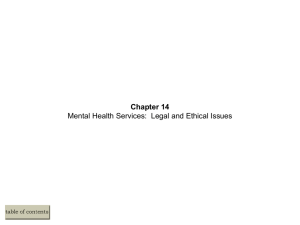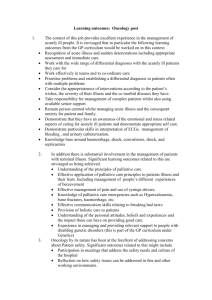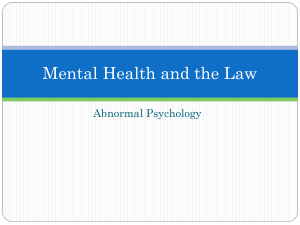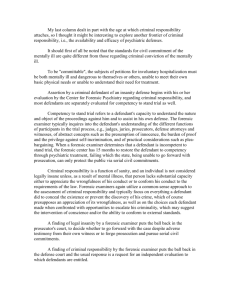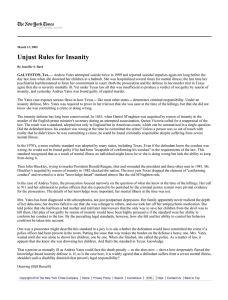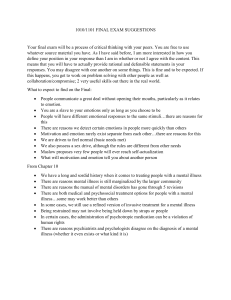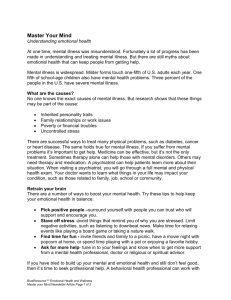Day 26 & 27: Ethical and Legal issues
advertisement
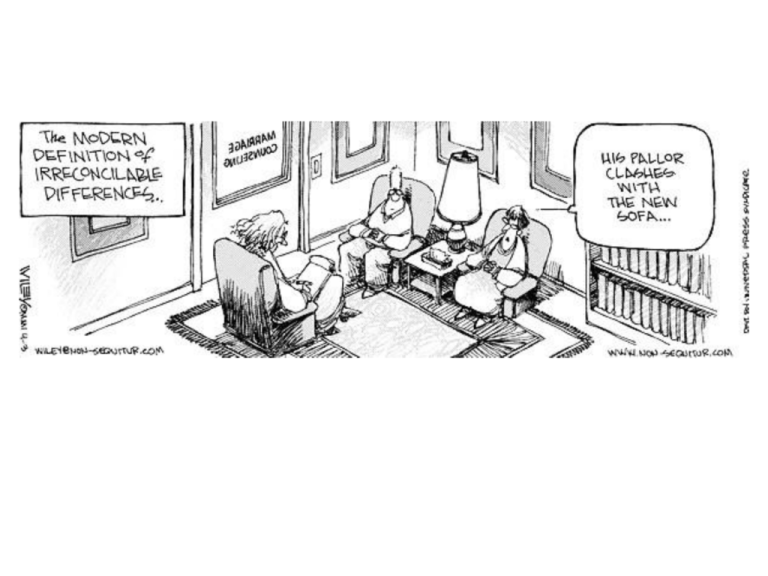
Legal and Ethical Issues Chapter 14 Mental Health and the Legal System: An Overview A variety of legal and ethical issues exist in regard to mental health and abnormal psychology The nature of civil vs. criminal commitment Balancing ethical considerations vs. legal considerations The role of psychologists in legal matters Expert witnesses, forensic psychology Rights of patients and research subjects Practice standards and the changing face of mental health care Civil Commitment: Overview, Criteria, and Oversight Authority Civil Commitment Laws Address legal declaration of mental illness Address when a person can be placed in a hospital or institution for treatment Such laws and what constitutes mental illness vary by state "Mental illness" means a substantial disorder of thought, mood, perception, psychological orientation or memory that significantly impairs judgment, behavior, capacity to recognize reality or ability to meet the ordinary demands of life; (OS §43A-1-103-3) Dangerousness to Self or Others: Central to Commitment Proceedings Assessing dangerousness: The role of mental health professionals Knowns and unknowns about violence and mental illness Civil Commitment General Criteria for Civil Commitment Demonstrate that a person has a mental illness and needs treatment (often exclude substance use/abuse) Show that the person is dangerous to self or others Bias based on gender, race/ethnicity Predicting groups with higher likelihood of dangerous behavior vs predicting individual’s likelihood of dangerous beh. Establish a grave disability – Inability to care for self Governmental Authority Over Civil Commitment Police power – Protection of the health, welfare, and safety of society Parens patriae – State acts a surrogate parent Civil Commitment - Changes Supreme Court cases prohibit confinement of nondangerous person who is capable of surviving by self or with help of willing & responsible family or friends More restrictive commitment laws may result in mentally ill being jailed for criminal offenses Deinstitutionalization movement led to increase in homelessness rate Of the 2.5 – 3.5 million homeless, 25-30% are mentally ill Lack of community mental health facilities to replace large inpatient hospitals The Civil Commitment Process Initial Stages (OK) Protective custody Emergency Evaluation (<12 hours) Emergency Detention (<72 hours) Subsequent Stages Involve normal legal proceedings in most cases Determination is made by a judge regarding whether to commit the person Criminal Commitment Insanity Defense M’Naghten Rule – do not know nature & quality of act performing, or did not know act was wrong Irresistible impulse – even if aware that act was wrong, no longer had power to choose between right & wrong (lacked free agency) Durham Rule – was criminal act the result of mental disorder? American law Institute Standard – because of mental illness/defect, must lack capacity to understand criminality of behavior or to avoid it (M’Naghten & Irresistible impulse); but cannot be result of antisocial or repeated criminal behavior Insanity Defense (cont’d) Insanity Defense Reform Act (1984) if due to mental illness or mental retardation unable to appreciate wrongfulness of conduct at the time of the offense Diminished capacity – mental illness can diminish ability to understand nature and impact of one’s behavior; issue of intent Public perception of frequency of insanity defense and the time of hospitalization is highly inaccurate Fewer than 1% cases use insanity defense Length of hospitalization often longer than prison term if had been convicted of the crime Guilty but Mentally Ill – convicted, but either go to prison or mental hospital, or combination of 2 (sentence given) Competency to Stand Trial Must be able to participate in own defense, understand the legal proceedings Typically sent to mental facility for treatment, if regain competency may then be brought to trial or may never be brought to trial Patient’s Rights: An Overview The Right to Treatment Mentally ill persons cannot be involuntarily committed without treatment Treatment includes active efforts to reduce symptoms and provide humane care The Right to the Least Restrictive Alternative Treatment within the least confining and limiting environment The Right to Refuse Treatment Often in cases involving medical or drug treatment Persons cannot be forced to become competent via taking antipsychotic medication Patient’s Rights: An Overview (cont.) The Right to Confidentiality vs. Duty to Warn Confidentiality – Protection of disclosure of personal information Limits to confidentiality Duty to Warn – Tarasoff Suspicion of neglect or abuse of children or “vulnerable adults” Court order Releases of Information The Right to Informed Consent Nature of treatment proposed Conditions of treatment, including confidentiality Alternatives to treatment Research Participant Rights: An Overview The Right to be Informed About the Research Involves informed consent, not simply consent alone The Right to Privacy Right to be Treated with Respect and Dignity Right to be Protected from Physical and Mental Harm Right to Chose or to Refuse to Participate in Research Without Negative Consequences Right to Anonymity with Regard to Reporting of Study Findings Right to Safeguarding of Records Clinical Practice Guidelines and Standards Agency for Health Care Policy and Research Focus on delivery of efficient and cost-effective mental health services Dissemination of relevant state-of-the-art information to practitioners Establish clinical practice guidelines for assessment and treatment American Psychological Association’s Practice Guidelines Standards for clinical efficacy research Standards for clinical effectiveness research Examples include APA Division 12 list of empiricallysupported treatments
